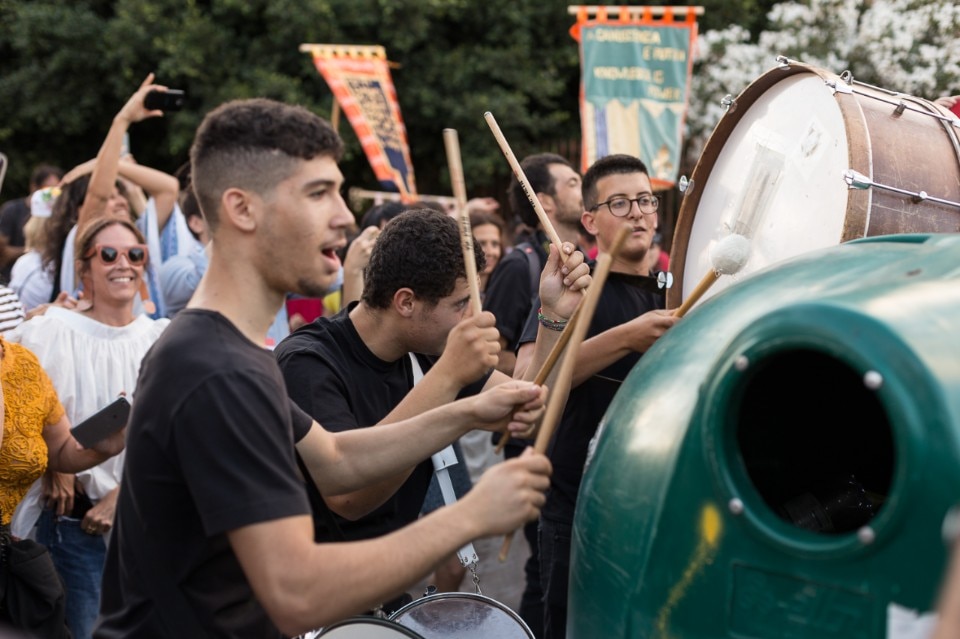Marinella Senatore, (Cava de’ Tirreni, 1977) is the author of one of the most anticipated opening events of Manifesta 12 Palermo. If one of the main objectives of the biennale is to interact with the city and its inhabitants, then the performance Palermo Procession is undoubtedly one of the most successful initiatives. The procession travelled the streets and lanes of the old city centre and involved over 300 non-professional performers. The result was a celebration which involved everyone, even those who were sceptical of contemporary art.

Tell us about the process of involvement which led up to Palermo Procession.
Every urban community is made up of countless fragments. Six months ago, I started mapping the interesting situations in the city. I collected accounts of Palermo from its inhabitants, trying to go beyond pre-conceived ideas. I like to interact with people who have something to say, to give or to do, and who feel the need to express themselves. These are rarely professional figures. I have been developing projects of public participation for 15 years now, and I have worked in many countries, with completely different cultures, customs and ideas. I was aware that I didn’t have a precise formula, and it is not my aim to impose my point of view. If this were not the case, mine would not be either a site-specific work or public art. I prefer dialogue, which obviously is not always free of conflict. But such conflicts exist, and they are resolved within the community. The procession is an opportunity for discussion and cohesion.
The city was an active participant in the procession: its architecture and its barriers, the marvels and the monsters. Everything.
Taking part in the parade, I felt it was a mix between Santa Rosalia and the May Day, a blend of devotion and participation. What traditional celebrations and processions inspired you?
I am very much attracted by combinations. In reality my main references come from afar, considering that I studied extensively abroad. I have experienced and studied Caribbean carnivals, processions that combine music, customs and social activism, in which the joy of life is a political factor. I have also studied in Africa, where I experienced post-colonial dances, which are very intense moments of collective emancipation. I know all local Italian traditional dances, but I also follow political or military parades. I am interested in all forms of ritual which involve the movement of people. Obviously, everyone in Palermo told me about Santa Rosalia, which I consider to be one of the most important choreographies in history, on a par with Martha Graham or Pina Bausch.
What elements of public space inspired you in choosing the route?
I never decide in advance. I left the choice of the route to the participants. We spoke a lot about how to interact with the road, and how its elements could be used in an expressive manner. The city was an active participant in the procession: its architecture and its barriers, the marvels and the monsters. Everything. The percussionists played shutters and dustbins; the parkour athletes hung from fences and churches, the classic ballerinas used railings as bars, the pole dancers danced on sign posts...

One of the most remarkable aspects of you work is the composition between different people, the creation of a new social fabric. In doing this, I think that you managed to create a true popular and contemporary narration of society, a genuine account of the motivations and needs of Palermo. As a procession is a linear composition, it is fundamental who is first and who follows. Tell us about your choices in this regard?
I try to blend languages that initially seem discordant - such as parkour and classical music, or bongos and majorettes. I want to present people with their history and reality, with all that that involves: uncertainty, fear or initial discomfort in finding oneself with strangers. My role is also to valorise individuals. For me, the participants are important as people and not as a mass. I speak honestly with everyone, and I prepare them for the unexpected, for sudden changes and for flexibility. For example, the parade was headed by a group of blind people, who I told: “if you go the wrong way, we will follow you”. Even if it is just for a short while, it is important that they experience their own reality, and not that of someone else. I am not interested in leading the blind by hand. This type of interaction and unexpected collaboration as just small changes in social fabric. We artists will not change the world, our responsibility is to provoke thought and generate small movements.













